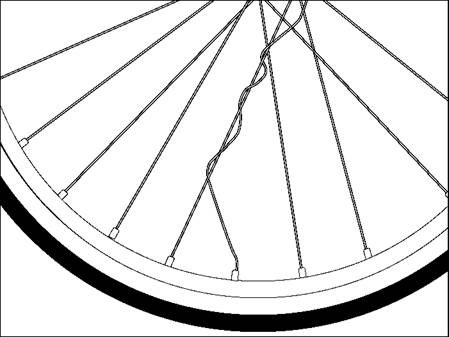Replacing a broken spoke
Wheels are amazing things: Even though they have rims that are suspended by, on average, 28 to 36 thin metal spokes, they can take a tremendous amount of punishment. A wheel gets its strength from the equal or balanced tension spread across its spokes. Remove a spoke, and this tension becomes unbalanced, causing the wheel to spin out of alignment or true, and potentially making the wheel unsafe to ride on.
The only permanent solution to a broken spoke is to replace it and retrue the wheel. But if you break a spoke while you’re riding, follow these steps to get yourself home:
1. Identify the broken spoke and remove it.
If you can’t remove the spoke, wrap it around one of the neighboring spokes, as shown in Figure 4-2.
|
|
2. If you have a replacement spoke, first remove the wheel and tire.
If you don’t have a replacement spoke or can’t replace it, loosen the two spokes that are adjacent to the broken spoke. This will help balance out the tension in the wheel and bring it somewhat back into alignment.
3. Insert the spoke through the hub hole and weave it through the other spokes in the same form as the rest of the spokes.
4. Insert the nipple through the rim, and tighten it using a spoke wrench from your emergency tool kit.
5. Tighten the spoke to a tension where it makes a similar sound when you pluck it like a harp as the sound made by plucking the rest of the spokes.
6. Spin the wheel to see if it has a bend and adjust the spoke tension to straighten it if needed.
|
|
|
Figure 4-2: A broken spoke wrapped around another spoke. |
Fixing flats and torn tires
|
|
You should always have your patch kit available when you ride, because sooner or later a flat will sneak up on you. (For instructions on how to change a flat, see Chapter 6.) It’s also good to have a spare tube on hand in case a tube blows out and can’t be patched.
Before you reassemble the wheel, don’t forget to inspect the tire and tube for the sharp object that caused the flat. Otherwise, you might be stuck on the side of the road repairing a flat in another five minutes.
If you have a torn or ripped tire, you’ll want to fix it as soon as possible or risk blowing the tube — especially if the tube has started protruding out through the tear. Bike stores sell tire boots, which you can use to reinforce the inside of the tire where the cut is located. If you don’t have a tire boot, there are a number of alternatives that’ll do the job. Dollar bills, duct tape, food wrappers, plastic cut from a soda bottle — you’re only limited by your imagination. (To repair or boot a tire, see the steps in Chapter 6.)



